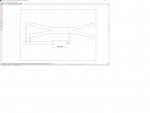Hi All,
I’m new to model trains and I would like advice on wiring a reverse loop on this DCC layout I have half built.
I understand how a NCE AR10 is wired into a standard loop setup. Mine looks different to standard
Or its just the way I look at it.
Look at BF200 double slip and travel towards area marked C. It comes back to the double slip making a reverse loop.
My thought is to put a Ar10 at BF200 double slip or is the double slip going to confuse things?
I thought I would ask before I try.
I have attached full layout and my plan for wiring it. Triangles on the double slip are insulators.
Thanks.
I’m new to model trains and I would like advice on wiring a reverse loop on this DCC layout I have half built.
I understand how a NCE AR10 is wired into a standard loop setup. Mine looks different to standard
Or its just the way I look at it.
Look at BF200 double slip and travel towards area marked C. It comes back to the double slip making a reverse loop.
My thought is to put a Ar10 at BF200 double slip or is the double slip going to confuse things?
I thought I would ask before I try.
I have attached full layout and my plan for wiring it. Triangles on the double slip are insulators.
Thanks.









